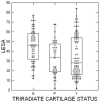Idiopathic Slipped Capital Femoral Epiphysis: Demographic Differences and Similarities between Stable, Unstable, and Valgus Types
- PMID: 37761517
- PMCID: PMC10528030
- DOI: 10.3390/children10091557
Idiopathic Slipped Capital Femoral Epiphysis: Demographic Differences and Similarities between Stable, Unstable, and Valgus Types
Abstract
Idiopathic slipped capital femoral epiphysis (SCFE) is a known disorder in pre/adolescent children with vague hip/knee pain. We wished to study the demographic differences between stable varus, unstable varus, and valgus idiopathic SCFEs using a retrospective review over a 10-year period of SCFE children seen at a tertiary children's hospital. Standard demographic data was collected, and radiographs were measured to determine the Southwick angle and status of the tri-radiate cartilage. There were 190 patients; 138 had stable varus SCFEs, 45 unstable varus SCFEs, and 7 valgus SCFEs. All unstable SCFEs were varus, and all valgus SCFEs were stable. There were significant differences between the three groups by age at diagnosis, sex, race, SCFE severity, weight percentile, and duration of symptoms. The average age at diagnosis was 11.0 ± 1.2, 11.8 ± 1.8, and 12.3 ± 1.7 years for the valgus, unstable varus, and stable varus groups (p = 0.019), and similarly, SCFE severity was 25° ± 15°, 48° ± 18°, and 35° ± 19° (p = 0.0002) for the three same groups. Patients with valgus SCFEs were mostly female (86%) compared to the stable varus (39.9%) and unstable (47%) groups (p = 0.05) and mostly non-White (86%) (0.011). The duration of symptoms was 4.1 ± 4.1, 2.3 ± 5.0, and 4.5 ± 5.0 months for the valgus, unstable varus, and stable varus groups (p = 0.00005). These three types of idiopathic SCFEs demonstrated differences by age at diagnosis, sex, race, weight percentile, and duration of symptoms.
Keywords: demographics; slipped capital femoral epiphysis; stable; unstable; valgus.
Conflict of interest statement
The authors declare no conflict of interest.
Figures




References
-
- Loder R.T., Greenfield M.L. Clinical characteristics of children with atypical and idiopathic slipped capital femoral epiphysis: Description of the age-weight test and implications for further diagnostic investigation. J. Pediatr. Orthop. 2001;21:481–487. doi: 10.1097/01241398-200107000-00013. - DOI - PubMed
LinkOut - more resources
Full Text Sources

